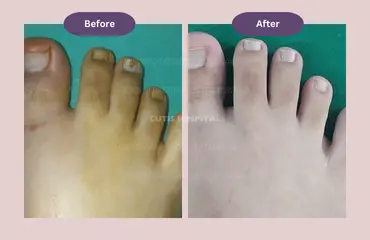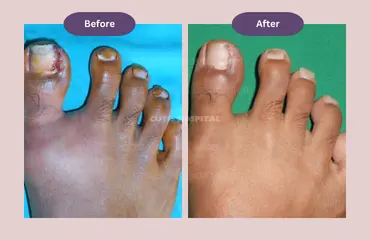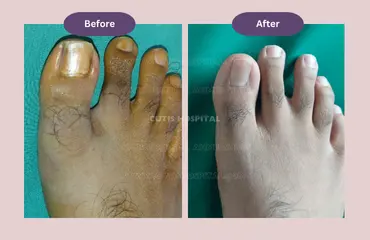Ingrown toenail is the condition that most commonly happens to the great toe of feet either on one or both sides. It occurs as a result of the abnormal downward/inward direction of growth of the nail of the toe. Due to the downward or internally inclined growth of the nail, it strikes against the skin in an attempt to come out of the skin. In this situation, it becomes challenging for the patient to trim the nail in the normal way.
Additionally, the slightest pressure from the outer aspect as may be by footwear or minor trauma, cuts the skin from within by pressing it against the advancing buried edge of the nail which leads to infection and pain. Such repeated episodes of infection and pain worsen the situation and if not treated, can frustrate the patient. The conventional method of treatment involves the removal of the edge of the nail causing the problem, which leads to temporary relief of symptoms only to reappear later. Permanent relief of this problem is ensured by permanently preventing nail growth at the offending corners.
The plastic surgery technique of nail bed removal ensures permanent relief of this problem by removing the nail bed responsible for nail growth at the corners. A permanent cure for this problem is achieved by precise anatomical knowledge, the use of magnification, and the fine surgical skill of a plastic surgeon.
To simplify, in grown toe nail is the problem related to nail of any digit, the corner of which abnormally grows towards the skin and strikes against the skin rather than growing normally above the skin and coming out over the skin. In grown toe nail most commonly affects the nail of the great toe either on one or both sides of the one or both toes.
Causes of in grown toe nail are not known in all the patients. However, the most common causes are external trauma over the toe nails as happens in sports, abnormal nail pairing habits, diabetic foot infections, repeated minor injuries, very tight foot wear and sometimes prolonged walking leading to continuous and sustained minor injury over the toe tips.
Ingrown toenail surgery is a minor surgery performed under local (ring block) anesthesia.
This surgery aims to cure the pain and prevent repeated episodes of infection at the corners of the nail.
To achieve these objectives, local anesthesia is infiltrated around the base of the great toe and after the digit is anesthetized completely, a tight encircling rubber band (digital tourniquet) is tied and tightened at the base, to prevent the blood from entering in to digit and facilitate the surgery. However, this tight digital tourniquet is released at the end of the surgery to restore the blood supply of the digit. After tying the digital tourniquet, incision is marked at two sites if one corner of the nail is affected and at four sites if both the corners of the nail are affected. Complete symptomatic relief at the problematic corner of the nail can only be achieved by ensuring permanent cessation of nail growth at the offending site. And this requires removal of the root of the nail called nail bed (germinal matrix) along its entire length from tip or corner of the nail to its deepest extension below the skin at the base of the nail. Thus, removal of whole strip of nail bed along its entire length is the key step for successful surgery leading to permanent cure. And this is the reason for incisions at two sites (one at the affected corner of the nail and another over the skin at the base of the nail).
After complete removal of entire length of nail bed is ensured, thorough wash with saline is given to remove small debris and then the incisions are closed meticulously with fine sutures. All these steps of operation are performed with fine dissection skills of plastic surgery with use of 4 – X Zeiss loupe magnification and delicate instruments. After sutures are completed, pressure dressing is applied and digital rubber tourniquet is released after the dressing is tightly applied.
Patient is instructed to have complete rest and elevate the operated leg over a pillow for at least 2 days after the surgery. First dressing is done after 3 days and then sutures are removed during second dressing after 6 – 7 days of surgery. Patient can join his/her routine work after 3 days of operation. However, sports activities and running should preferably be avoided till 3 weeks after the surgery.
At Cutis Hospital, all patients of ingrown toe nail surgery are provided with personalized care by our expert and experienced plastic surgeon Dr. Chintan Patel. And this care starts right from the first visit of the patient. Patients are explained in detail about the phenomenon of ingrown toe nail and the measures required for its permanent cure. All steps of surgery are carried out by Dr. Chintan Patel himself at Cutis Hospital, and he examines all operated patients of ingrown toe nail during their follow up visits.
After ingrown toe nail surgery, patients are advised to rest at home keeping the operated limb elevated over a pillow. The bed rest and limb elevation are maintained for 2 days and patient is asked to avoid going school or office for these 2 days. From third day onwards, patient can move around and can start attending his work. First dressing after the surgery is done on 3rd day after the surgery and then after 3 days of first dressing, sutures are removed. Patient needs to do few protective dressings by himself for a week after the suture removal, which is explained in details and demonstrated to the patient and his family members. Patient is allowed to wear shoes between 7 to 14 days after the surgery. Strenuous activities like sports and running can be resumed usually after 3 weeks.
Avoiding any trauma to the toenails helps a lot to prevent this problem from developing. Improper or very deep trimming of corners of nails is also to be avoided. Very tight shoes should be avoided. Taking proper care of feet is also helpful in avoiding developing ingrown toenails, especially in diabetic patients. However, despite all preventive measures, an ingrown toenail is not always preventable. Whenever symptoms develop, like pain, redness, and swelling at one or both corners of the toenail, the patient should immediately consult a plastic surgeon to seek early and permanent relief.




Yes, this problem is completely curable.
No, removal of entire nail will temporarily solve the problem. As soon as the nail grows and reaches at the corners (which might take 1.5 to 3 months), the same cycle of pain and infection at the corners of nail starts again.
Yes, in almost all cases, chances of permanent cure from ingrown toe nail are very high, irrespective of the number of previous failed procedures. In fact, most of the patients of ingrown toe nails presenting to Cutis hospital have already undergone one or more than procedures before.
For a permanent cure of the ingrown toe nail problem, nail growth at the affected corner of the toe must be prevented forever. This is achieved by a plastic surgeon by removing the nail bed (germinal matrix) from underneath the skin at the base of the nail. Removal of this nail bed (germinal matrix) responsible for the growth of the nail at the corners of the toe ensures permanent cessation of nail growth at the corner and thus cures the problem forever.
Non-treated or wrongly treated ingrown toe nail patients many times end up having gross deformity and loss of normal composition of nails with development of crooked, rigid nails which becomes very difficult or impossible to correct.
In this scenario, permanent ablation of nail is the best and safe option. This will save the patient from repeated episodes of pain, infection and trauma due to deformed nail, but the patient has to take extra care and protection due to permanent loss of nail.
Cutis Hospital is conveniently located in Ghatlodia, Ahmedabad, making it easily accessible via multiple modes of transportation. Below are the various ways you can reach our facility:
Sardar Vallabhbhai Patel International Airport: Located approximately 12.7 km from Cutis Hospital, offering convenient access for patients traveling from outside the city.
Chandlodiya Railway Station: Approximately 2.4 km from Cutis Hospital.
Ahmedabad Railway Station: Around 11 km from our center.
GSRTC:
Ahmedabad Central Bus Station (GSRTC): About 10.3 km from the hospital.
AMTS:
Bhuyangdev Cross Road Bus Stop: Just 500 meters from Cutis Hospital.
BRTS:
Bhuyangdev BRTS Bus Stop: Only 170 meters from our center.
We provide effective surgical and non-surgical treatments for all parts of the body. At Cutis Hospital, our cosmetic and plastic surgery team is committed to giving patients safe and high-quality care.